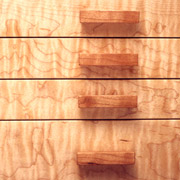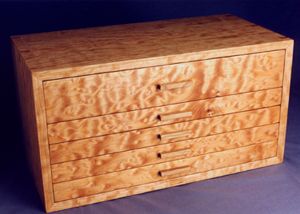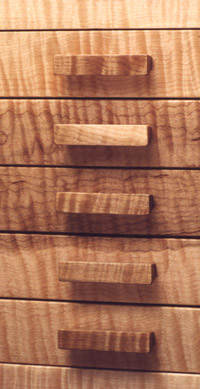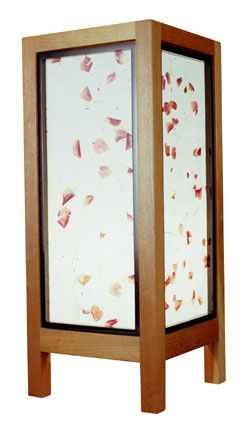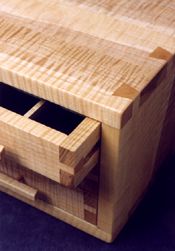 |
|
|
|
|
|
Techniques and Materials
Solid hardwood is my basic material and the one with which I am most familiar. It is versatile, strong, and of course beautiful. And like people, it gets better with age. Many cabinetmakers use veneer, dyes, and various composites as a matter of course. This has its place; it's just not what I do. I prefer solid wood, exposed construction, hand rubbed finishes, and little or no decoration. When I am successful, the piece acquires character through it's proportions, materials, and joinery. Form should follow function.
|
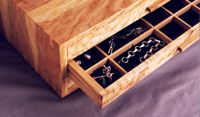
Mitered Chest 3
|
 |
|
 |
|
|
|
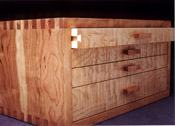
Finger Joint Chest 1
|
|
Typically I work with native hardwoods, mostly cherry, red maple, and sugar maple. Figured wood is preferred when available. The lumber is cut to rough length, face jointed, and planed with standard machine tools. I cut the various joints using a combination of hand and machine tools, and then assemble the piece. Joinery includes dovetails, mortise and tenon, box joints, and various hybrids.
|
 |
|
|
|
|
|
Some specific details:
~Drawers are always dovetailed. In my humble opinion, it is the only joint that will last in a drawer.
~All case and drawer parts are solid wood except drawer bottoms and case backs, which are Baltic birch, a premium cabinet grade plywood imported from Europe.
~Black cotton velvet is attached to the bottom before assembly for a clean and seamless drawer lining.
~Drawer dividers are solid maple and are adjustable. (link)
~Interior surfaces are finished with shellac.
|
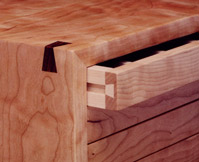
Mitered Chest 1
|
|
 |
|
|
|
 |
|
|
|
|
|
|
|
|
Varieties of Wood Used
Following is a brief description of the species of trees that I normally use. For more information on botanical details, consult the National Audubon Society's excellent Field Guide to North American Trees, Eastern Region, published by Knopf. For more on the technical characteristics of hardwood lumber, consult R. Bruce Hoadley's comprehensive text, Understanding Wood, published by Taunton Press.
|
 |
|
|
 |
 |
|
 |
|
|
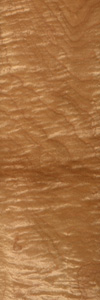
Sugar Maple
|
|
Sugar maple (acer sacchurum), also known as rock maple or hard maple, is a common and familiar member of the Maple family. It occurs primarily in the northeastern United States and southeastern Canada, and under ideal conditions will reach a height of 120' and diameter of three to four feet. A long lived, hardy, and handsome tree, it is famous for maple syrup and the most magnificent autumnal foliage of any tree in the world. It is among the strongest and most durable timbers, and is widely used in the furniture and flooring industries. Occasionally, sugar maple trees develop unusual figure or grain patterns which are exceptionally beautiful and striking, such as birdseye, curly, and fiddleback maple. A large portion of these trees, particularly birdseye maple, are sawn into veneer. Thus the solid wood is difficult to find and in great demand among cabinetmakers and instrument builders, often commanding prices four to five times that of typical sugar maple. I usually use highly figured sugar maple for drawer fronts, door panels, tabletops and pulls. Typical sugar maple is straight grained and cream colored, and I frequently use it for drawer parts and interior work in cabinets.
|
|
 |
|
|
 |
|
|
|
|
|
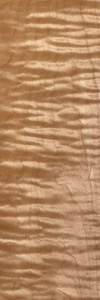
Red Maple
|
|
Red maple (acer rubrum) is another common member of the Maple family, and occurs over the entire eastern US from Maine to the Gulf Coast. It is very tolerant and is widely planted as a shade tree. Commonly known as soft maple, it also produces beautiful figure variations, mainly curly and tiger stripe maple. These variations are frequently intense, so much so that the wood appears to glow with it's own light. Typical red maple is unassuming and straight grained, somewhat darker than sugar maple. It too is used commercially, though not as widely as sugar maple. I use figured red maple much in the same way as figured sugar maple, for drawer fronts and door panels. |
|
 |
|
|
 |
|
|
|
|
|

Black Cherry
|
|
Black Cherry (Prunus serotina), or common cherry, belongs to the very large Rose family, which also includes the numerous hawthorns and well as common fruit trees such as apple, plum, peach and pear.
It occurs east of the Mississippi River from Nova Scotia to the Gulf Coast. Under ideal conditions, cherries will grow up to 120' high and five feet across. The importance of cherry as a cabinet wood was recognized early on, and it has probably been costly since colonial days. This is due to the fact that it is almost perfect as a cabinet wood. It is straight grained and free of knots, and it is easy to work. It takes a finish well, ages beautifully, and is very stable. That is, it tends not to warp, and shrinks and swells but little. Pennsylvania produces the finest cherry in the world, frequently with a wavy, rolling figure. Cherry is frequently stained or dyed a darker tone; this was originally done to make it look like mahogany. Left to its own devices, it ages from a medium pinkish red to a deep crimson, a process that continues for years. With cherry, the aging process is caused by light as well as oxidation, and if you leave objects on a new cherry table, you will get "tan lines." To avoid this, it's a good idea to let the piece get a head start of a year or two. Besides cabinetry, cherry is also used for flooring, toys, and scientific and measuring instruments. I use cherry for casework, drawers, door frames and panels.
|
|
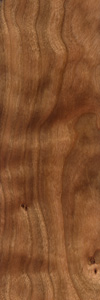
Figured Black Cherry
|
 |
|
|
 |
|
|
|
|
|

Black Walnut
|
|
Black Walnut (juglans nigra) is a part of the Walnut family, which includes hickories and walnuts. It is found throughout the mid-Atlantic states, from Texas to the Dakotas eastward. Walnut prefers rich, fertile bottomland, and is famously slow growing. In the original forest, it reached 150 feet high and six feet across. Black walnut is among the rarest and most sought after cabinet woods, now virtually extinct in the wild. Most of what is cut today is from yard trees or abandoned farm fields, and a good deal of that ends up as veneer. Like cherry, it's importance as a cabinet wood was recognized early on, and it possesses the same fine qualities of workability and stability. It is dark and heavy, with the figure varying from relatively straight grained to somewhat wavy. No other native tree comes close to the rich and complex tones of walnut, which may run from purple and brown to near black, with hints of reds and greens. Walnuts make wonderful shade trees, though some vegetables, notably tomatoes, will not thrive near a mature walnut.
|
|
 |
|
|
 |
|
|
|
|
|
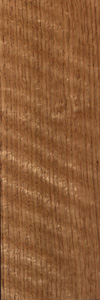
Red Oak
|
|
Northern Red Oak (quercus rubra) is member of the large and extensive Beech family, which includes chestnuts, beeches, and oaks. It is found from Nova Scotia to Wisconsin and south to Alabama, and is among the fastest growing oaks. Red oak began to be heavily used when white oak became scarce. It is widely used in the furniture and flooring industry, and is commercially the most important red oak species. Usually red oak is plain sawn, and this produces the familiar cathedral like figure common to all oaks. Quartersawn red oak, on the other hand, is practically a different wood. It machines and finishes differently, but the biggest difference is in its stability. Plainsawn red oak tends to be very reactive and unstable, while quartersawn red oak is among the most stable timbers, more so than even cherry or walnut. I use quartersawn red oak for all types of casework, as well as drawers and doors. |
|
|
|
|
|
|
Return to top of page
|
 |
|
|
|
|
|
|
|




